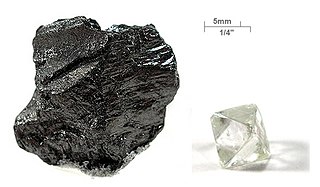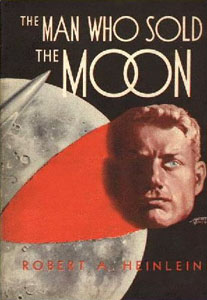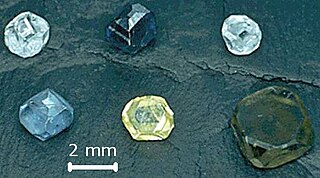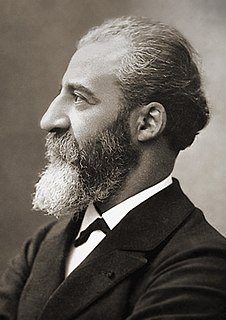Related Research Articles

Carbon is a chemical element with the symbol C and atomic number 6. It is nonmetallic and tetravalent—making four electrons available to form covalent chemical bonds. It belongs to group 14 of the periodic table. Carbon makes up only about 0.025 percent of Earth's crust. Three isotopes occur naturally, 12C and 13C being stable, while 14C is a radionuclide, decaying with a half-life of about 5,730 years. Carbon is one of the few elements known since antiquity.

"The Man Who Sold the Moon" is a science fiction novella by American author Robert A. Heinlein, written in 1949 and published in 1950. A part of his Future History and prequel to "Requiem", it covers events around a fictional first Moon landing in 1978 and the schemes of Delos D. Harriman, a businessman who is determined to personally reach and control the Moon.
The Deptford Trilogy is a series of inter-related novels by Canadian novelist Robertson Davies.

Carbonated water is water containing dissolved carbon dioxide gas, either artificially injected under pressure or occurring due to natural geological processes. Carbonation causes small bubbles to form, giving the water an effervescent quality. Common forms include sparkling natural mineral water, club soda, and commercially-produced sparkling water.

Moissanite is naturally occurring silicon carbide and its various crystalline polymorphs. It has the chemical formula SiC and is a rare mineral, discovered by the French chemist Henri Moissan in 1893. Silicon carbide is useful for commercial and industrial applications due to its hardness, optical properties and thermal conductivity.

William Kelly, born in Pittsburgh, Pennsylvania, was an American inventor. He is credited with being one of the inventors of modern steel production, through the process of injecting air into molten iron, which he experimented with in the early 1850s. A similar process was discovered independently by Henry Bessemer and patented in 1855. Due to a financial panic in 1857, a company that had already licensed the Bessemer process was able to purchase Kelly's patents, and licensed both under a single scheme using the Bessemer name. Kelly's role in the invention of the process is much less known.

Lab grown diamond is diamond that is produced in a controlled technological process. Unlike diamond simulants, synthetic diamonds are composed of the same material as naturally formed diamonds – pure carbon crystallized in an isotropic 3D form – and share identical chemical and physical properties.

Ferdinand Frédéric Henri Moissan was a French chemist and pharmacist who won the 1906 Nobel Prize in Chemistry for his work in isolating fluorine from its compounds. Moissan was one of the original members of the International Atomic Weights Committee.
"The Chronic Argonauts" is an 1888 short story by the British science-fiction writer H. G. Wells. It features an inventor who builds a time machine and travels in time using it, and it pre-dates Wells's best-selling 1895 time travel novel The Time Machine by seven years.

Falling Up is a 1996 poetry collection primarily for children written and illustrated by Shel Silverstein and published by HarperCollins. It is the third poetry collection published by Silverstein, following Where the Sidewalk Ends (1974) and A Light in the Attic (1981), and the final one to be published during his lifetime, as he died just three years after its release. Falling Up was the recipient of the Booklist Editors' Award in 1996.. In 2015, a special edition of the book was published, with 12 new poems.

The Train to Lo Wu is a collection of short stories by Jess Row published in January 2005. The book contains seven loosely related stories set in or related to Hong Kong. They all deal with the tension felt between insiders and outsiders, especially between locals and foreigners visiting for study or work.

Mind uploading, whole brain emulation, or substrate-independent minds, is a use of a computer or another substrate as an emulated human brain. The term "mind transfer" also refers to a hypothetical transfer of a mind from one biological brain to another. Uploaded minds and societies of minds, often in simulated realities, are recurring themes in science-fiction novels and films since the 1950s.

"Herbert West–Reanimator" is a horror short story by American writer H. P. Lovecraft. It was written between October 1921 and June 1922. It was first serialized in February through July 1922 in the amateur publication Home Brew. The story was the basis of the 1985 horror film Re-Animator and its sequels, in addition to numerous other adaptations in various media.
"Venture to the Moon" is a group of six linked science fiction short stories by English writer Arthur C. Clarke. It was originally published in the British newspaper Evening Standard in 1956. The stories describe the first crewed mission to the Moon in 1975, as a joint American-Russian-British mission, and are narrated in first person from the point of view of the British team commander. Despite the death described in the third story, they are written in a humorous vein. They are collected in The Other Side of the Sky.

Charcoal is a lightweight black carbon residue produced by strongly heating wood in minimal oxygen to remove all water and volatile constituents. In the traditional version of this pyrolysis process, called charcoal burning, often by forming a charcoal kiln, the heat is supplied by burning part of the starting material itself, with a limited supply of oxygen. The material can also be heated in a closed retort. Modern "charcoal" briquettes used for outdoor cooking may contain many other additives, e.g. coal.
"A Deal in Ostriches" is a short story by the British writer H. G. Wells. It is a cautionary tale about simple human greed. The taxidermist of Wells’ story "Triumphs of a Taxidermist" (1894) makes a return appearance as the narrator of the story.
"Light of Other Days" is a science fiction short story by Irish writer Bob Shaw. It was originally published in August 1966 in Analog Science Fiction and Fact. The story uses the idea of "slow glass": glass through which light takes years to pass. Bob Shaw used this idea again in later stories.
"The Cone" is a short story by H. G. Wells, first published in 1895 in Unicorn. It was intended to be "the opening chapter of a sensational novel set in the Five Towns", later abandoned.

"Æpyornis Island", or "Aepyornis Island", is a short story by H. G. Wells, first published in 1894 in the Pall Mall Budget. It was included in The Stolen Bacillus and Other Incidents, the first collection of short stories by Wells, first published in 1895.

"Loss of Breath", also known as "Loss of Breath: A Tale Neither In Nor Out of 'Blackwood' ", is a short story written by American author Edgar Allan Poe under the pseudonym "Littleton Barry". A satirical tale, the story is narrated by Mr. Lackobreath who recounts his attempt to find and reclaim his lost breath, which he had literally misplaced. Throughout his journey, he is repeatedly dismembered and disfigured, falsely assumed to be dead, hanged, locked away, and prematurely interred. The absurd exaggerations may be explained by the fact that the tale was meant to satirize fiction published in the Edinburgh Blackwood Magazine, which was known for its sensational texts.
References
| Wikisource has original text related to this article: |
- ↑ The Diamond Maker title listing at the Internet Speculative Fiction Database, accessed 16 March 2014.
- ↑ Artificial Diamonds,[ dead link ] Human Touch of Chemistry, accessed 16 March 2014.
- ↑ History of Man Made Diamonds Man Made Diamond Information, accessed 16 March 2014.